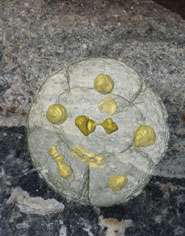570 million year old multicellular spore body undergoing vegetative nuclear and cell division (foreground) based on synchrotron x-ray tomographic microscopy of fossils recovered from rocks in South China. The background shows a cut surface through the rock - every grain (about 1 mm diameter) is an exceptionally preserved gooey ball of dividing cells turned to stone.
Tiny fossils that scientists have thought for decades were the embryos of the earliest animals ever found have turned out to be the remains of much simpler microbial organisms.
In a Science paper that's likely to dismay many palaeontologists, an international team of researchers describe how they used X-rays from a specialised particle accelerator to model the internal structure of hundreds of the 580-million-year-old microfossils in three dimensions.
The results left little doubt that the fossils are from single-celled organisms of an evolutionary grade that came before complex, multi-cellular animals. The fossils occur as clumps of cells, representing different stages in a process of progressive division, just like the early stages of embryonic development seen in animals like humans.
But unlike animal embryos, where the cells organise themselves into tissues and organs, the X-ray examination revealed the fossil organism simply carried on dividing to produce hundreds of thousands of spores that were eventually released to be distributed by ocean currents.
'These deposits were supposed to be the earliest unequivocal evidence of complex animal life, 50 million years before the next oldest animal fossils,' says Professor Philip Donoghue of the University of Bristol, one of the paper's authors. 'If that had been true, they would have had the potential to shed a huge amount of light on early animal evolution.'
Sadly, it isn't. 'We were very surprised by our results,' he adds. 'We've been convinced for so long that these fossils represented the embryos of the earliest animals - much of what has been written about the fossils for the last ten years is flat wrong. Our colleagues are not going to like the result.'
Video showing 570 million year old multicellular spore body fossilised while undergoing vegetative nuclear and cell division. The computer model is based on on synchrotron x-ray tomographic microscopy of these tiny fossils recovered from rocks in South China. Courtesy of Stefan Bengtson, Swedish Museum of Natural History.
So if they're not embryos, what are they? Donoghue says the likeliest explanation is that the fossilised organisms belonged to the living group Mesomycetozoa, also known as 'drips'. These are close unicellular relatives of true animals, and mostly live as parasites on animals such as salmon and shellfish. The drips show a tendency towards multicellularity, with amoeba-like mother cells dividing repeatedly to produce clusters of tiny spores of amoebas, just like the fossils.
Normally such organisms don't fossilise, having no hard parts like bones or shells, so we have very limited records of them. These specimens were preserved only because they were buried in phosphate-rich sediments and sea water that gradually turned their internal structure to stone. If the embryo theory had been true, the fossils would be a goldmine of information about how the embryos of very early animals developed. But these results seem to eliminate that possibility.
The tiny, spherical, very numerous fossils were found in the Duoshantuo Formation in southern China in the late 1980s. Early analysis tentatively identified them as algae, but this idea was quickly abandoned in favour of the animal embryo hypothesis. An alternative idea was proposed in 2007 that these were fossilised giant bacteria that lived on sulphur.
Another paper published recently in Proceedings of the Royal Society B by Donoghue and his colleagues demolished the bacteria interpretation, showing that the Doushantuo microfossils have an internal structure that couldn't possibly be that of giant sulphur-reducing bacteria.
And now the Science paper has done the same for the more popular animal embryo hypothesis. If the fossils do turn out to be the remains of a member of the drip family, they will provide us with the first rock-solid evidence for the emergence of multicellularity early in the evolution of the lineage in which animals eventually arose.
'We used a particle accelerator called a synchrotron as our X-ray source,' says co-author Dr John Cunningham of Bristol. It allowed us to make a perfect computer model of the fossil that we could cut up in any way we wanted, but without damaging the fossil in any way. We would never have been able to study the fossils otherwise!' The team used the Swiss Light Source synchrotron in Zurich.
More information: Huldtgren, T., Cunningham, J. A., Yin, C., Stampanoni, M., Marone, F., Donoghue, P. C. J. and Bengtson, S. 2011. 'Fossilized nuclei and germination structures identify Ediacaran "animal embryos" as encysting protists' in Science 334.
Journal information: Science
Provided by PlanetEarth Online
This story is republished courtesy of Planet Earth online, a free, companion website to the award-winning magazine Planet Earth published and funded by the Natural Environment Research Council (NERC).
























